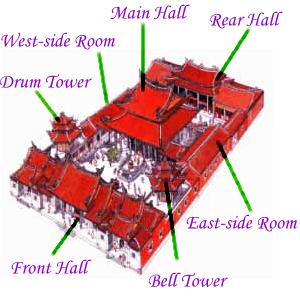
|
Layout of LungShan Temple |
|
|
|
Before a temple is ever built, a lot of preparatory work must be done. A fengshui expert must check the lay of the land and determine the proper orientation of the structure. The Chinese pantheon, furthermore, has a set hierarchy that any modern-day civil service functionary would find quite familiar. What is more, and the size of the temple as well as the number of its doors depends on the “rank” of the god to whom the temple is dedicated. Lungshan Temple has three
pavilions: the front hall, the main hall, and the rear hall. The main
hall stands by itself in the center of the courtyard, which is enclosed
on the left and right by a row of buildings on either side. This layout
is common to Buddhist and Confucius temples of all sizes. |
 |
Lungshan Temple is dedicated to Guanyin, a boddhisatva who ranks very high in the Buddhist pantheon. According to an ancient Chinese tradition, temples dedicated to Guanyin can be oriented on a perfect north-south axis, with the front gate pointing to the south, but Lungshan Temple has been rotated about two degrees off true north as a sign of humility. |
|
What is the orientation of your home? Does the front door face south? |
|
•Written by Tsu-Yi and photographed by Chui-Hiu
